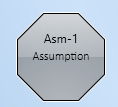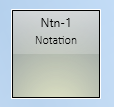The nodes are listed in the left hand side menu of the Map screen and you drag and drop from the menu to add them the canvas or you can right click on the canvas and select 'New Node' from the context menu that appears.
Now that we know what a node is and how to add them to the map, let's have a quick look at the uses and properties of the default nodes in Realisor.
Initiative
Initiatives represent packages of work or activity that result in new, changed or maintained capabilities. Examples include, ‘create new IT system’, ‘run an education programme’, ‘buy and run a car’, ‘sell goods and services’.
Each Initiative represents the investment and action needed to create value (performance) that contributes realise the outcomes expected. They are sometimes called programmes, projects or interventions - in Realisor they are the high level work package that will deliver some new or changed capability to an organisation or person. They contribute value and they are the traditional focus of programme and project management. Initiatives can be linked to outcomes and objectives with performance links.
On each Initiative, there are a number of qualities. For example, you can perform an Initiative to varying levels of quality. The default two types of Quality are None and Optimal but additional qualities can also be added. For example, None signifies that no Initiative is taking place; Optimal that it is done to the best level possible and you might want to have different levels of quality between those two to signify either a growing level of quality over time or different levels of quality that can be chosen - this enables cost/capability trade off.
Outcome
An Outcome is something that is of value to a person or enterprise. They
represent the things that the organisation wants more of, less of, to
have new, to get rid of or to stay the same. Outcomes
can be positive and have benefits such as reducing downtime, improved
customer image, reduced headcount or outcomes can be negative and have
a detrimental impact such as poor press exposure, loss of brand
value.
Having one Outcome realised can contribute to additional Outcomes
being realised, shown by the links and contribution weights. An example
is that an Outcome of ‘increased staff skills’ may contribute to an
Outcome of ‘increased ability to serve customers’. Outcomes therefore
can be linked/contribute to one another creating a ‘flow of value’.
Objective
The
Objective node is used in benefits realisation management modelling to
scope the programme or investment and help understand what is important
to the enterprise.
Sometimes an Outcome map is created with just Objectives on to
understand what is important to the enterprise - these are agreed by
senior stakeholders so all contributors have a common context. Then
Outcomes are added onto the outcome map for the programme/ investment
and linked to one or more of these Objectives. The Objectives not
directly linked to can be said as being out of the scope of this
programme/ investment.
Programmatic Nodes: Process, Component, Project & Function
These nodes all have the same properties - they can be fully costed and resource requirements added to the. They represent the functions, projects, processes and components that need to be undertaken to reach a Capability level and thus one of the Quality levels of an Initiative.
Capability
It is important to understand what an organisation or thing is able to do now and wants to be able to do – these are Capabilities. Capabilities help everyone to be clear on what capacity/ abilities are expected and what is needed to get or sustain them (e.g. using the programmatic nodes above). So, Capabilities define what an organisation or thing wants to or is capable of doing to achieve specific effects, declared goals or objectives. Some examples are to have the Capability for:
•a person to operate a certain type of machine
•an IT network to handle a certain amount of traffic
•a process to complete in a certain amount of time
•an organisation to operate in different countries
Assumption and Notation
 Assumption nodes and notation nodes are
used to record important assumptions being made while creating the model
or to share the information with the other stakeholders to improve the
clarity of the model.
Assumption nodes and notation nodes are
used to record important assumptions being made while creating the model
or to share the information with the other stakeholders to improve the
clarity of the model. Building up a
map of outcomes and initiatives is useful but without the assumptions
that people have about them, then the map does not truly reflect
reality. For example, to increase the skills of its people, there are
assumptions that the people will be freed from their day job to take
part in training. You can hold assumptions about anything and therefore
assumptions can link to any other node on the model.
Building up a
map of outcomes and initiatives is useful but without the assumptions
that people have about them, then the map does not truly reflect
reality. For example, to increase the skills of its people, there are
assumptions that the people will be freed from their day job to take
part in training. You can hold assumptions about anything and therefore
assumptions can link to any other node on the model.
Notation nodes can
be used for adding information about the model, for example, title,
author, date and version. They can also be used to link to nodes to
provide additional annotation.
Requirement and Strategy
Any programme/design needs to meet a large number of requirements
that are needed by customers. It is essential that key requirements are
identified and how they are going to be satisfied is shown. By doing
this confidence is increased that the programme/design has all the
necessary elements in place.
The requirement node allows the visual capture of all requirement types, along with the linkage of these requirements to other map components, to both hold the requirements and understand their impact upon a programme. Strategic node is similar to the Requirement node. It is used to model the strategic requirements on the map.
Risk
The risk node itself represents a collection of sub risks (from 0-> many) and is used to capture and inform decision making about risk. Risks can be associated with anything else on the model. It is important to understand the key risks involved in a programme/design so that their likely impact can be managed and likely costs identified.
Stakeholder
Understanding Stakeholders is key to the success of any change and various approaches are used. This node enables the capture of important information regarding program/project stakeholders. Different ways to use the stakeholder node can be found here.
Dependency
Dependency nodes can be used to annotate dependencies between nodes.








